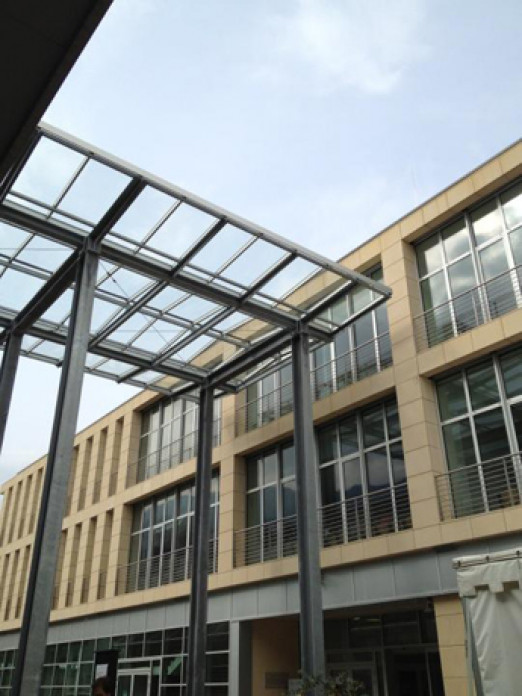The striking tower on the extension of the PHÄNOMENTA Science Centre in Lüdenscheid has the potential to become a famous landmark and a symbol of architectural and engineering excellence. Based on a feasibility study by schneider+schumacher, the interdisciplinary collaboration between KKW Architekten, WERNER Bauingenieure and formTL Ingenieure created an impressive steelwork truss tower that encompasses a helix shaped membrane stretched over its interior.
By applying the tower-in-tower principle, this primary structure encloses a Foucault pendulum that is suspended independently of the secondary bearing structure. This defined separation allows the pendulum to move freely without being influenced by wind and vibrations from the primary structure, thus allowing visitors to the Science Centre to observe the Earth's rotation.
The tower is just one part of the extension to PHÄNOMENTA: a two-storey extension creates an additional 1,400 m2 of exhibition space and zones characterised by expressive forms. This is a direct is a result of the requirements of the tower's geometry but it also ensures the functionality of the exhibition space. The monolithic design of the concrete building also serves as the foundation for the distinctive steel structure. The framework consists of diagonally supported struts throughout the concrete structure and the elegant light-weight steel truss tower structure is made up of triangular circular hollow tube sections that are welded airtight. The complex design, incorporated nodes where up to six pipes meet at various angles, required a comprehensive 3D CAD analysis. Membrane forces associated with pretensioning and wind are channelled directly into the junctions with a view to preventing excessive bending stress on the frames. In order to facilitate with hoisting and assembling of the individual tower segments, special screw connections were arranged in the frames beside the junctions and covered with special semi-cylindrical metal sheets. This eliminated the need for welding work at heights and concealed the segmentation sections.
The helix membrane inside the steelwork supporting structure appears delicate and light – "a structure that is almost barely there," as described by formTL CEO Gerd Schmid – and yet it is still visually impressive. The helix consists of just three structural components: 990 m² of membrane, three structural cables and nine anchoring rods with clamps. These elements are sufficient to enable the membrane to adhere to the rotating and vertically tapered tower structure. While the calculated maximum form guarantees collision clearance from the outer tower tubes, the calculated minimum form prevents disturbances with the inner pendulum structure. The curved helix structure has a particularly striking effect at night, when the back-lit seams of the membrane and the shadows of the ropes converge upwards to form a cone shape, lending the tower an even loftier appearance. KKW Architekten developed the light planning for this impressive illumination feature in partnership with Winkels Behrens Pospich Ingenieure für Haustechnik GmbH (wbp). wbp was also responsible for the technical building fittings including the light management of the LEDs.
The Foucault pendulum suspended from the secondary bearing structure not only helps visitors to “experience” the rotation of the Earth. The exhibition space below designed by designers from beier+wellach projekte is home to the stunning Phänorama: a 360º-projection of Lüdenscheid and the surrounding area that is controlled by the oscillation duration of the 30m-long pendulum similar to an oversized kaleidoscope.
Client: Stiftung PHÄNOMENTA Lüdenscheid/GER
Architect: KKW ARCHITEKTEN, Altena/GER
Linus Wortmann, Julia Düppe, Corinna Cardaun, Svenja Asmann, Eduardo Abarca
Architecture feasibility study: schneider+schumacher, Frankfurt/GER
Bearing structure planning for steel tower and solid structure, fire protection, heat protection:
WERNER Bauingenieure, Menden/GER
Günter Werner, Dr Daniel Werner, Detlef König, Tim Berg, Stefan Hostert, Henrik Sträter, Christoph König
Membrane helix: Bearing structure planning tender procedure, site management: formTL ingenieure für tragwerk und leichtbau gmbh, Radolfzell/GER
Gerd Schmid, Christian Würfl, Ciprian Tripon, Katrin Kaltenbrunner, Christoph Singer
HVAC: WINKELS BEHRENS POSPICH Ingenieure für Haustechnik GmbH, Münster/GER
Andreas Winkels, Michael Wellmeier, Alexander Löwen, Markus Grote, Björn Scholthaus, Jörg van Look
Exhibition planner: beier+wellach projekte, Berlin/GER
Ruudi Beier




